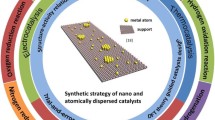Abstract
The standard enthalpy of formation of 1,4-diethynylbenzene experimentally to be 500.6 ± 6.7 kJ/mol. Calculations show that 1,4-diethynylbenzene has a relatively high adiabatic combustion temperature (about 1970 K at a pressure of 5 atm) and very high heat of combustion in oxygen (42 MJ/kg); therefore, 1,4-diethynylbenzene can be used as the basis to develop an effective dispersing agent of solid fuel that provides an adiabatic combustion temperature of up to 2500 K at a heat of combustion far exceeding the values provided by HMX and the other azides of N-heterocycles previously proposed for this purpose.
Similar content being viewed by others
References
N. A. Ahmed, A. I. Kitaigorodsky, and M. I. Sirota, “Crystal Structure of p-diethynylbenzene,” Acta Cryst. B28 (9), 2875–2877 (1972)
L. S. Yanovskii, D. B. Lempert, V. V. Raznoschikov, I. S. Averkov, and M. M. Alekseeva, “Possibility of Using High-Enthalpy Compounds As Solid Propellant Components,” in Fundamentals of Ballistic Design, VI All-Russian Sci. and Tech. Conf., St. Petersburg, June 5-10, 2018 (BSTU, St. Petersburg, 2018), pp. 203–204.
A. N. Kizin, P. A. Dvorkin, G. L. Ryzhova, and Yu. A. Lebedev, “Parameters for Calculating the Standard Enthalpies of Formation of Organic Compounds in the Liquid Phase,” Izv. Akad. Nauk SSSR, No. 2, 372–375 (1986).
“Gaussian 03, Revision D.01” (Gaussian, Inc., Walling-ford, CT 2004).
L. A. Curtiss, P. C. Redfern, and K. Raghavachari, “Gaussian-4 Theory Using Reduced Order Perturbation Theory,” J. Chem. Phys. 127, 124105 (1–8) (2007).
P. Politzer, J. S. Murray, M. E. Grice, M. DeSalvo, and E. Miller, “Calculation of Heats of Sublimation and Solid Phase Heats of Formation,” Mol. Phys. 91, 923–928 (1997).
Ya. O. Inozemtsev, A. B. Vorob'ev, A. V. Inozemtsev, and Yu. N. Matyushin, “Calorimetry of Energetic Compounds,” Gorenie Vzryv, No. 7, 260–270 (2014).
A. I. Kazakov, D. V. Dashko, A. V. Nabatova, A. I. Stepanov, and D. B. Lempert, “Thermochemical and Energy Characteristics of DNTF and DNFF,” Fiz. Goreniya Vzryva 54 (2), 27–38 (2018); DOI: 10.15372/FGV20180203 [Combust., Expl., Shock Waves 54 (2), 147–157 (2018)].
Experimental Thermochemistry, Vol. 1: Measurement of Heats of Reaction, Ed. by F. D. Rossini (Intersciences, New York, 1956).
Thermal Constants of Substances: A Handbook, Ed. by Acad. V. P. Glushko (Izd. Akad. Nauk SSSR, Moscow, 1965) [in Russian].
D. B. Lempert, S. V. Chapyshev, A. I. Kazakov, N. A. Plishkin, A. V. Shikhovtsev, and L. S. Yanovskii, “Thermochemical and Energy Characteristics of Di-, Tri- and Tetra-Azido-Substituted Azines as Gasifying Agents of Solid Fuels for Ramjet Engines,” Fiz. Goreniya Vzryva 55 (1), 27–36 (2019) [Combust., Expl., Shock Waves 55 (1), 23-31 (2019)].
B. G. Trusov “TERRA Software System for Modeling Phase and Thermal Chemical Equilibria,” in XIV Int. Symp. on Chemical Thermodynamics (St. Petersburg, 2002), pp. 483–484.
Author information
Authors and Affiliations
Corresponding author
Additional information
Original Russian Text © D.B. Lempert, I.N. Zyuzin, A.V. Nabatova, A.I. Kazakov, L.S. Yanovskii.
Rights and permissions
About this article
Cite this article
Lempert, D.B., Zyuzin, I.N., Nabatova, A.V. et al. Thermochemical and Energy Characteristics of 1,4-Diethynylbenzene. Combust Explos Shock Waves 55, 644–647 (2019). https://doi.org/10.1134/S0010508219060029
Received:
Accepted:
Published:
Issue Date:
DOI: https://doi.org/10.1134/S0010508219060029




